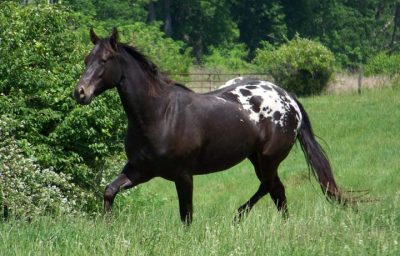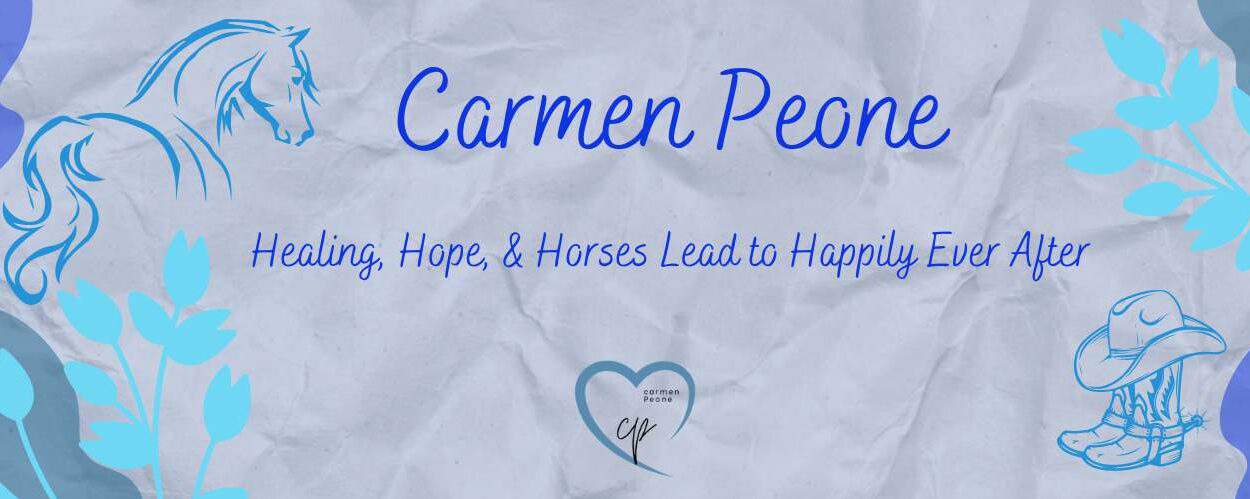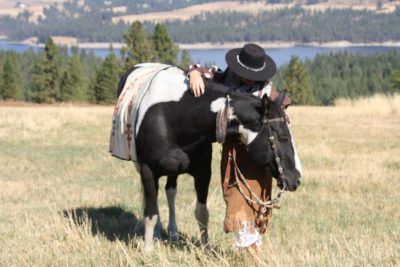Native Horses

Natives obtained their first horses from Spanish explorers in 1540. Some of those original horses escaped and turned wild and are now coined Mustangs.
The first horse used by Natives, now having its own registry, is the American Indian Horse. Its ancestry consists of Spanish Barb, Arabian, Mustang, or “Foundation” Appaloosa descent. Toss in the Andalusian bloodline and the creature was considered the finest horse of the time.
Color breeds trace back to these bloodlines as well: Paint, Palomino, Appaloosa, and Buckskin to name a few.
Dogs were used by Natives for carrying small portable shelters until the horse arrived, allowing the people to haul decorative hide tipis. Or in some areas tule-mat tipis.
Hunting also changed in practice. The primary method of hunting large game was to run a herd over a cliff. Once Natives got their hands on horses, they hunted off the animal’s backs, able to outrun prey.
By 1700, various northwestern tribes owned horses including Bannock, Nez Perce, Cayuse, Umatilla, and tribes that now make up the Colville Confederated Reservation.
Trading was in full tilt in the early 1800s. The going rates for horses were:
• 1 ordinary riding horse = 8 buffalo robes
• 1 fine racing horse = 10 guns
• 1 fine hunting horse = several pack animals
• OR 1 gun and 100 loads of ammunition
• OR 3 pounds of tobacco
• OR 15 eagle feathers
• OR 10 weasel skins
• OR 5 tipi poles
• OR 1 buffalo-hide tipi cover
• OR 1 skin shirt and leggings, decorated with human hair and quills
Let’s face it, who wouldn’t love to drop everything and go for a ride?
In Hannah’s Journey, Hannah Gardner rode both Paints and won an Appaloosa.
Excerpt
“Loot!” Running Elk once again uncinched my saddle. He sneered at Falling Rain and motioned for her to set hers on the ground. With a scowl she complied.
I groaned, slid the saddle off Moonie, and set in on the grass. With an extra-hard whack, I settled the pad on top.
Falling Rain set hers back down.
They hopped on their horses with ease. I tried to lift myself up with a couple hops, but failed. I led Moonie over to an old log and heaved myself on her back. The other two looked at me like I was about to give them something bitter to taste.
“Well? Let’s go!” The word patience came to mind. I scoffed and planted the pouch hung around my neck inside Delbert’s shirt. As heavy as Falling Rain’s doeskin dress and leggings were, I was amazed by her agility. I was thankful for boys’ britches. I couldn’t imagine hopping up on Moonie with a dress and all the underclothing required by a lady. But then again I’m no lady. Not yet anyway.
We raced up and down the meadow and somehow I managed to stay on. Until Running Elk had another harebrained idea.
Review
Exciting, fast-paced, and totally in tune with the vacillating emotions of a horse-loving, teenage girl. Right from the beginning Carmen Peone’s book, Hannah’s Journey, immerses the reader in the world of a 16-year-old girl, struggling with family disapproval and the criticism of those who do not believe a girl should cross the cultural and gender boundaries of the 1870’s. Throughout the story, Hannah’s determination and stubbornness cause her difficulties, but these same qualities help her succeed at what she most wants—to race against the boys at the Sinyekst Indian Village near her home. It is, however, Hannah’s inner struggles and soul-searching that allow her to make peace with her family and move forward with her life. Hannah’s Journey is a wonderful mix of story, horses, spirituality, and striving for inner understanding.
Goodreads Book Giveaway
Hannah’s Journey
by Carmen Peone
Giveaway ends October 24, 2017.
See the giveaway details
at Goodreads.



I recall reading a book in grade school about the Llanos (treeless plains in Bolivia) where the followers of Simon Bolivar rode bareback. They learned to ride as little tykes and, as they grew, their feet and legs actually “grew around” their horses’ bellies. They grew into very bow-legged men who struggled to walk on flat ground, but were agile riders. I recall thinking then, “Wow! Why not just use a saddle?” Any explanation why bareback was preferred? Loved the piece.
That’s interesting, Judith. I know Natives rode bareback a lot, but not always. Especially when moving locations during the seasons while following the food source. Women rode with saddles a lot. Riding bareback is great for kids and balance, I used to ride that way a lot. Now, not so much. It’s simple just to catch the horse and hop on and not have to tack up. Also, it’s warmer during cooler months.
Love the info on the horses. Love your new book HANNAH’S JOURNEY
Thank you, Mom!
Great post! Can I borrow your info on what horses cost? I’ll share this post on the blog I want to use this information on.
Thank you! Yes, you can.
Very interesting blog, Carmen. I love learning more about Native life. I always learn something from your blogs.
Thank you, Mary! I’m glad you always have a take home. Never know when something will come in hand.